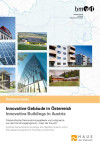Suchergebnisse für "Factsheet: Energietechnologien gestalten, die für alle sinnvoll und nutzbar sind"
Film-DVD: Bauen für die Stadt der Zukunft

Dauer: 50 Minuten
Gestaltung: Claudia und Peter Giczy nach einer Idee von Michael Paula
Mehrsprachig
Sanierungsleitfaden - Neue Standards für alte Häuser international

Tschechischer Untertitel: "Leitfaden für die Sanierung von Einfamilienhäuser im 21. Jahrhundert"
52/2013
E. Haselsteiner, K. Guschlbauer-Hronek, M. Havel, J. Hollan
Herausgeber: BMVIT
Tschechisch, 77 Seiten
Zukunftshof - Zukunftshof Rothneusiedl - Crystallization point of a climate model district
Transdisciplinary expert networking to develop a structural, thermal, and energy-efficient renovation concept, as well as a master plan with innovative energy, monitoring, green space, and agricultural utilization concepts. The result serves as a source of ideas for contemporary revitalization and forms the basis for the implementation of the demonstration project.
E.Vent – Efficient, cost-effective and low-maintenance central ventilation systems for multi-family housing – Design, operation and fire protection measures
Die Synopsis ist eine drei- bis vierzeilige Beschreibung des Projektinhalts alsErgänzung zum Titel und nähere Erläuterung des Projekts.
Urban Future - "Resource Efficient City of Tomorrow"
Challenges fort he cities of tomorrow with research issues referring to resource management, efficiency and technology development
e-retrofit kit - tool kit for passive house retrofit
Development of an internet-based tool for passive house retrofit für - target group social housing companies. Actualization of tool after test and evaluation in case-studies. dissemination activities in austria.
New standards for old houses - concrete
The campaign is, orientated on the target group, a linked extension of the reconstruction guidance "Neue Standards für alte Häuser" ("New standards for old houses") on the building trade and subconstruction work as well as on the awarding authority.
NEST international - New standards for old houses international
The main goal was to raise awareness for energetic renovations of settlement houses due to the handbook "Neue Standards für alte Häuser" in Slovakia and the Czech Republic. In doing so, the refurbishment potential has been identified in the target countries, experiences exchanged and information transferred. Contacts to the relevant target groups have been established.
Technology Platform Photovoltaic Austria
Between research institutions and the economic system the way has been paved to initiate joint R&D projects. Common research activities have been initiated and intensified to be able to position local companies in international niche markets for photovoltaics.
Recommendations for a consolidated Austrian research in the topic of "Smart Cities"
Based on a clear definition of the topics and focusing on energy relevant aspects the project will provide an overview on the present points of focus in research on "Smart Cities". Furthermore, future research topics will be defined and evaluated, and action plans for political stakeholders will be elaborated in the framework of two expert workshops.
RaumCoop 2.0 - Space Cooperative, a systematic operational model for activating unused or underutilized spaces.
The RaumCoop organizes the sharing of spaces, mobilizes underutilized spaces for non-residential purposes in the ground floor area, and makes them available for temporary use at affordable conditions. The goal of the project is to establish this non-profit organization.
Development of a solid-wood-passivehouse-window
Based on experience with low-energy-windows, a solid wood window is being developed, which meets passivehouse-standards.
MADOKLI - Mannersdorf climate fit! Using local resources to combat and adapt to climate change for a climate-neutral neighbourhood
Development of a climate-neutral neighbourhood by integrating previously unused heat sources and sinks, such as the underground Mühlbach stream, to supply municipal buildings, to establish use-oriented water management and to develop solutions for climate-friendly outdoor spaces in the centre of Mannersdorf am Leithagebirge.
Modernizing by Catalogue

Façade and Open Space Modernization with Standard Building Components in Housing of the Fifties und Sixties.
Insulation material made of cattail
Development of the production technology for cattail insulating materials. Basis study to the feasibility of a serial production.
Designing Synergies. Spatial and Energetic Transformation Scenarios for Small Towns and Municipalities Using the Example of the Wagram Region (Lower Austria).
An interdisciplinary exploratory project that synergistically analyses strategies for the activation of vacant buildings and the potential for the formation of small-scale energy communities. The starting point is student projects from the Institute of Architecture and Design, TU Wien, for four municipalities in the Wagram region. On this basis, an interdisciplinary team of experts is developing a concept for a synergy cluster focussing on spatial energy planning, building physics, the circular economy and social innovation.
Broschüre: Innovative Gebäude in Österreich - Technical Guide

Österreichische Demonstrationsgebäude und Leitprojekte aus dem Forschungsprogramm "Haus der Zukunft"
Herausgeber: BMVIT
Mehrsprachig, 84 Seiten
Downloads zur Publikation
Co-Housing Gutenberg: Integrated Sector Coupling for Shared Living, Energy, and Mobility
The "CoHoGutenberg" project aims to establish a sustainable co-housing model in the rural community of Gutenberg, Styria, by combining sufficiency principles with state-of-the-art energy technologies.
FavoriteFlows – Innovative solutions for water and energy cycles in buildings for a climate fit city
Demonstration of detailed planning work and implementation of water cycles (building-integrated constructed wetland wastewater treatment) and energy cycles (wastewater heat exchanger) on a large residential apartment development for climate resilience, resource efficiency and high living standard.
ReSpace – Reclaiming Spaces
ReSpace is developing an AI-based model for identifying, categorizing, and activating sealed areas. Existing data sources (aerial and satellite images, mobile network data, land registry entries) are integrated and enhanced with dynamic analysis to derive evidence-based recommendations for action.
